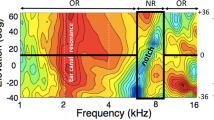Abstract
Sounds heard over headphones are typically perceived inside the head1 (internalized), unlike real sound sources which are perceived outside the head (externalized). If the acoustical waveforms from a real sound source are reproduced precisely using headphones, auditory images are appropriately externalized and localized1,2,3,4. The filtering (relative boosting, attenuation and delaying of component frequencies) of a sound by the head and outer ear provides information about the location of a sound source by means of the differences in the frequency spectra between the ears as well as the overall spectral shape. This location-dependent filtering is explicitly described by the head-related transfer function (HRTF) from sound source to ear canal. Here we present sounds to subjects through open-canal tube-phones and investigate how accurately the HRTFs must be reproduced to achieve true three-dimensional perception of auditory signals in anechoic space. Listeners attempted to discriminate between ‘real’ sounds presented from a loudspeaker and ‘virtual’ sounds presented over tube-phones. Our results show that the HRTFs can be smoothed significantly in frequency without affecting the perceived location of a sound. Listeners cannot distinguish real from virtual sources until the HRTF has lost most of its detailed variation in frequency, at which time the perceived elevation of the image is the reported cue.



Similar content being viewed by others
References
Hartmann, W. M. & Wittenberg, A. On the externalization of sound images. J. Acoust. Soc. Am. 99, 3678–3688 (1996).
Wenzel, E. M. Localization in virtual acoustic displays. Presence Teleop. Virt. Environ. 1, 80–107 (1992).
Wightman, F. L. & Kistler, D. J. Headphone stimulation of free-field listening I: stimulus synthesis. J.Acoust. Soc. Am. 85, 858–867 (1989).
Zahorik, P., Wightman, F. L. & Kistler, D. J. in Proc. Acoustics, Speech and Signal Processing (Institute of Electrical and Electronics Engineers) Workshop Appl. Signal Processing Audio Acoustics(IEEE Press, New York, 1995).
Kistler, D. J. & Wightman, F. L. Amodel of head-related transfer functions based on principal components analysis and minimum-phase reconstruction. J. Acoust. Soc. Am. 91, 1637–1647 (1991).
Kulkarni, A., Isabelle, S. K. & Colburn, H. S. Sensitivity of human subjects to head-related transfer function phase spectra. J. Acoust. Soc. Am.(submitted).
Oppenheim, A. V. & Schafer, R. W. Digital Signal Processing(Prentice-Hall, Englewood Cliffs, NJ, 1975).
Loomis, J. M. & Soule, J. I. in Proc. Society for Information Display 1996 Int. Symp. 965–968 (Society for Information Display, San Jose, CA, 1996).
Shaw, E. in Binaural and Spatial Hearing in Real and Virtual Environments (eds Gilkey, R. H. & Anderson, T. R.) 25–48 (Lawrence Erlbaum, Mahwah, NJ, 1997).
Author information
Authors and Affiliations
Corresponding author
Rights and permissions
About this article
Cite this article
Kulkarni, A., Colburn, H. Role of spectral detail in sound-source localization. Nature 396, 747–749 (1998). https://doi.org/10.1038/25526
Received:
Accepted:
Issue Date:
DOI: https://doi.org/10.1038/25526
- Springer Nature Limited
This article is cited by
-
Automatic discrimination between front and back ensemble locations in HRTF-convolved binaural recordings of music
EURASIP Journal on Audio, Speech, and Music Processing (2022)
-
Deep neural network models of sound localization reveal how perception is adapted to real-world environments
Nature Human Behaviour (2022)
-
Further observations on a principal components analysis of head-related transfer functions
Scientific Reports (2019)
-
Spectral Weighting Underlies Perceived Sound Elevation
Scientific Reports (2019)
-
Learning to localise weakly-informative sound spectra with and without feedback
Scientific Reports (2018)





